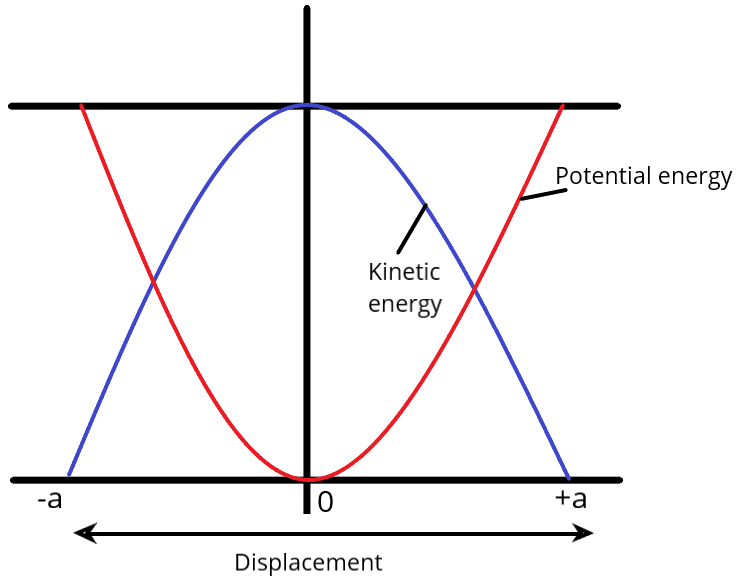
Displacement between maximum potential energy position and maximum kinetic energy position for a particle executing simple harmonic motion is.
Answer
216.3k+ views
Hint: According to the law of conservation of energy, the system's overall energy will never change. For straightforward harmonic motion, the displacement of the particle from the mean location determines the exchange of kinetic and potential energy.
Complete step by step solution:
In order to know that the expression of the kinetic energy is:
\[K = \dfrac{1}{2}m{\omega ^2}({a^2} - {x^2})\]..…. (1)
where m is the mass of the body, ω is the angular frequency, a is the amplitude and x is the position of the particle.
And, the expression of potential energy is:
\[U = \dfrac{1}{2}m{\omega ^2}{x^2}\]…… (2)
where m is the mass of the body, ω is the angular frequency, a is the amplitude and x is the position of the particle.

We observe that at the mean position \[(x = 0)\], kinetic energy is maximum \[\left( {\dfrac{1}{2}m{\omega ^2}{a^2}} \right)\] and potential energy is minimum or zero.
Also, at extreme positions \[(x = \pm a)\], kinetic energy is zero and potential energy is maximum \[\left( {\dfrac{1}{2}m{\omega ^2}{a^2}} \right)\].
Thus, the displacement between positions of maximum potential energy and maximum kinetic energy is \[ \pm a\].
Note:Here, it's important to keep in mind that the system's overall energy should not change. The answer will then be aided by the fact that the energy of the Simple Harmonic Oscillator only totally transforms from one form to another.
Complete step by step solution:
In order to know that the expression of the kinetic energy is:
\[K = \dfrac{1}{2}m{\omega ^2}({a^2} - {x^2})\]..…. (1)
where m is the mass of the body, ω is the angular frequency, a is the amplitude and x is the position of the particle.
And, the expression of potential energy is:
\[U = \dfrac{1}{2}m{\omega ^2}{x^2}\]…… (2)
where m is the mass of the body, ω is the angular frequency, a is the amplitude and x is the position of the particle.

We observe that at the mean position \[(x = 0)\], kinetic energy is maximum \[\left( {\dfrac{1}{2}m{\omega ^2}{a^2}} \right)\] and potential energy is minimum or zero.
Also, at extreme positions \[(x = \pm a)\], kinetic energy is zero and potential energy is maximum \[\left( {\dfrac{1}{2}m{\omega ^2}{a^2}} \right)\].
Thus, the displacement between positions of maximum potential energy and maximum kinetic energy is \[ \pm a\].
Note:Here, it's important to keep in mind that the system's overall energy should not change. The answer will then be aided by the fact that the energy of the Simple Harmonic Oscillator only totally transforms from one form to another.
Recently Updated Pages
JEE Atomic Structure and Chemical Bonding important Concepts and Tips

JEE Amino Acids and Peptides Important Concepts and Tips for Exam Preparation

Electricity and Magnetism Explained: Key Concepts & Applications

Chemical Properties of Hydrogen - Important Concepts for JEE Exam Preparation

JEE Energetics Important Concepts and Tips for Exam Preparation

JEE Isolation, Preparation and Properties of Non-metals Important Concepts and Tips for Exam Preparation

Trending doubts
JEE Main 2026: Application Form Open, Exam Dates, Syllabus, Eligibility & Question Papers

Derivation of Equation of Trajectory Explained for Students

Hybridisation in Chemistry – Concept, Types & Applications

Understanding the Angle of Deviation in a Prism

Understanding Collisions: Types and Examples for Students

How to Convert a Galvanometer into an Ammeter or Voltmeter

Other Pages
JEE Advanced Marks vs Ranks 2025: Understanding Category-wise Qualifying Marks and Previous Year Cut-offs

Units And Measurements Class 11 Physics Chapter 1 CBSE Notes - 2025-26

NCERT Solutions For Class 11 Physics Chapter 8 Mechanical Properties Of Solids

Motion in a Straight Line Class 11 Physics Chapter 2 CBSE Notes - 2025-26

NCERT Solutions for Class 11 Physics Chapter 7 Gravitation 2025-26

Understanding Atomic Structure for Beginners




